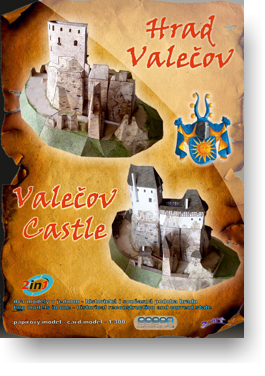

History of Valečov Castle
Valečov Castle is located on sandstone rocks near Boseň village, in Mladá Boleslav district, Czech Republic.
The castle was established by the family of Valečov at the beginning of 14th Century, the first written document comes from 1324. The first known owners were father and son, both called Bartoš of Valečov. The Valečov family was very extended and many of their members lived in the castle. During the Hussite wars, the castle belonged to the Hussite governors Bernart and Bartoš of Valečov, who supported Jan Žižka both politically and soldierlike. They even built a yard to accommodate Hussite troops during the winter.
In 1439, the castle was conquered and burnt down by Jindřich of Vartemberk, who dragged the recent residents - Machna and the orphans Vaněk and Břeněk - who remained at the castle after the male residents were killed in war –into his own castle in Děčín and who forced them to give up the castle in his behalf. However, in 1443, the castle was back in the family of Valečov´s hands and shortly after, it was renovated.
After the family of Valečov died out, the castle switched its owners often. The last permanent residents were the Kapouns of Svojkov. After them, the castle dilapidated and gradually turned into ruins. Only a few rooms carved into sandstone still accomodated poor people till the beginning of 20th century. In 1903, the castle was bought by the Czech Tourist Club who secured the walls and entrance ways, built a concrete bridge and staircase, conserved the palace and built a wooden house for the guides. After the WW2, the castle was owned by TJ Spartak who did not really care about it. In 1994, Boseň village bought the castle. They secured passageways and staircases and made the castle accessible for tourists.
The disposition of the castle is very ragged due to its position on the rocks. The most interesting thing about the castle are 57 rooms, carved into sandstone. 26 of them were habitable, the rest of them served as storage rooms or passageways. The core of the castle is made of three blocks of rocks – the one in the middle was the most important as the palaces were built on it. Among the stone rooms, there is an access to the upper platform – this is typical for rock castles. The Old Castle was probably made mainly of wood before the fire in 1439. After the fire, both the Old and the New Palaces were made of grout and stone. The New Palace was bulit in a kidney shape. It was the most important place of the castle. It had five floors (some of them were underground). It is supposed that after the fire, a new yard with farm and support buildings, lined with defense walls, was built. Due to numerous battles and steady pressure, the outer palace walls were built first and divided into rooms later. The walls were made so that larger stones were on the outside, small stones were inside and grout was poured among them.
We can find a rock tower with several carved rooms among the rocks on the north side. On the southern side, there is a rock rib with several rooms that were carved into sandstone as well. There were several wooden buildings, too. On the eastern side, there is a passageway carved into the rock – this used to be the entrance into a spacious place with rooms carved into stone and wooden houses. This place was able to accommodate many people even during the winter. Most probably this was the hiding place for Hussite troops.
Valečov is one of the most complicated and largest rock castles in the Czech Republic. Nowadays, you can visit the castle and explore the rooms carved in stone.
 Valečov Castle-current state 01 |
 Valečov Castle-current state 02 |
 Valečov Castle 03 |
 Valečov Castle 04 |
 Valečov Castle 05 |
 Valečov Castle 06 |
 Valečov Castle 07 |
 Valečov Castle 08 |
 Valečov Castle 09 |
You can order in our e-shop.
Back


